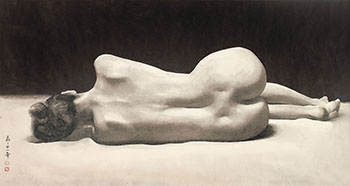PROVENANCE:
Galerie Frank Pagès, Geneva
Private collection, Asia
EXHIBITED:
Qu Leilei, China Ink , Galerie Frank Pagès, Geneva,
May 27 - July 19, 2014.
Catalogue Note:
Qu Leilei is one of the founders of The Stars Group. He settled in London in 1985, and became the President of the British Foundation for Chinese Painting and Calligraphy in 1999. He started combining ink wash with lights and shadows as he grew familiar with traditional European art. He strived to recreate the qualities of Renaissance masterpieces using Chinese ink wash and Xuan paper. In this way, his works are unique. They are unlike western paintings because he uses Chinese writing brush, ink wash, and Xuan paper, but they also differ from the traditional Chinese Southern School painting. He integrates the sort of lines seen in Southern School works with the professional technique of creating tonalities by ink wash layers. Thus, his works have both the western realism and the charm of Chinese paintings. He is truly a master of his own class, making both Chinese and western techniques his own. Qu is especially skillful with depicting lights - this is a distinguishing self-created feature in his art.
The quintessential technique employed by Qu Leilei is the focus on lighting. In particular, his recent works on human bodies emphasize reflections by light. In fact, all of the contrasts and shadows are the result of lighting. Even the sense of distance and the intensity of the ink depend on his control of illumination. The detailed depiction of lights and shadows makes the subject real, and this realism is what he is fond of for any given artwork. Furthermore, he arranged models that appear like white marble figures, radiating and exquisite, in a scroll with Arabesque patterns. This not only contrasts the structure and texture, but also creates a pleasant harmony between the blots and lines, the immobile and the mobile. With clever characterization of lights, Qu overcomes the reliance on lines in traditional Chinese paintings. Consequently, his style is very memorable. By blending lights and shadows with ink, Qu has perfectly combined the western with the eastern, and the traditional with the modern.
